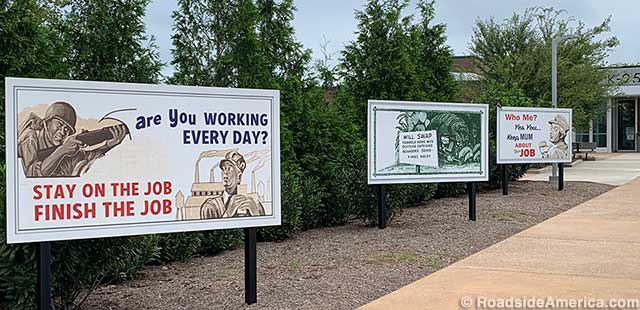
"Keep mum about this job." World War II billboards outside the building entrance.
K-25 History Center
Oak Ridge, Tennessee
Oak Ridge, Tennessee, was built as a secret, closed city -- population 75,000 -- during World War II. Its only purpose was to turn uranium into fuel for an atomic bomb.
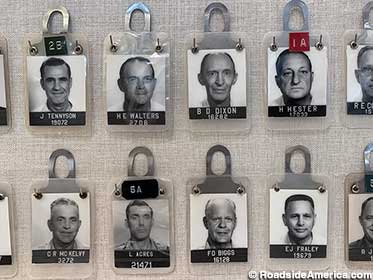
Everyone older than 11 had to wear a photo badge.
If you just dig up uranium, stick it in a bomb, and drop it on something, it won't explode. Uranium only causes a nuclear fireball if it's been purified, or "enriched." That was the job of K-25. Inside it, uranium -- which had been turned into a gas -- was passed though a series of filters with microscopic holes. The parts of the uranium that passed through were more bomb-worthy than the parts that didn't.
The process sounds straightforward, but was in fact incredibly complicated. K-25 required an immense building, the largest in the world at the time, covering nearly 44 acres, with a workforce of 12,000 people. It was so big that the staff rode bicycles indoors to get from one section to another.
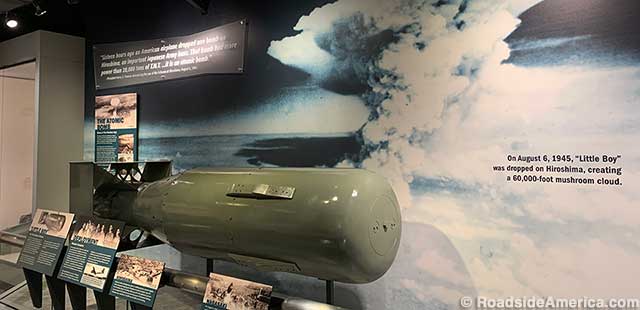
Replica of Little Boy, dropped on Hiroshima, fueled by uranium from K-25.
K-25 made bomb-capable uranium until 1964, then less-demanding radioisotopes until 1985. Cleaning up the nuclear waste and tearing down K-25 took another 35 years. The last pieces of the demolished building were hauled away in early 2020, and then the K-25 History Center opened at the south edge of the site -- and closed a week later due to Covid-19. The secrets of Oak Ridge weren't given up easily.
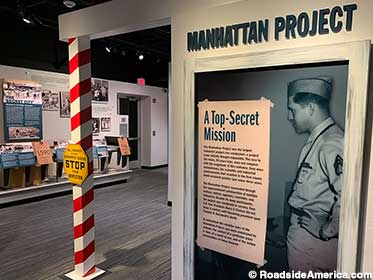
K-25: part of the Manhattan Project that built the first atom bomb.
Now reopened, the K-25 History Center is entered through a replica security checkpoint, where visitors watch a video that barks at them as if they were WWII workers, ordering them to never reveal what they are about to see. Quinn Argall, the Center's director of collections and exhibits, told us that some former K-25 employee-visitors still adhere to this rule. "They're not sure of what they're allowed to say," he told us. "They don't really talk about it."
The signature exhibit of the Center is its exact replica of "Little Boy," the atom bomb dropped on Hiroshima in 1945, which was fueled by the uranium enriched at K-25. Despite its name, Little Boy isn't little; it weighed nearly five tons. The imitation bomb on display was built, Quinn said, in the 1970s, as an unusual volunteer project by one now-forgotten man. "He said he could build a few Little Boy replicas," Quinn said. "I think he built three or four." The replica, said Quinn, is accurate enough, although picky purists sometimes question the number of rivets near the tail fins.
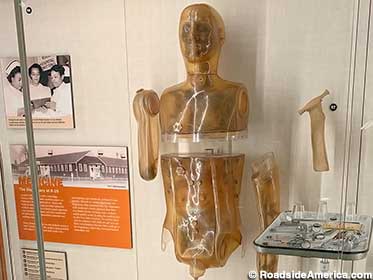
REMAB dummy was filled with organs, exposed to radiation.
The Center has plenty of bona-fide relics as well -- all now safely non-radioactive -- many of them simply found, abandoned, in the vast, empty building, and salvaged as it was torn down. The largest is Criticality Unit 1, a strange-looking one-of-a-kind firetruck that could be driven anywhere, spraying special "borated" water to neutralize radioactive leaks. The smallest is probably the Eleanor Roosevelt sugar packet, a favorite artifact of Quinn's, and one that is often overlooked by visitors. "I guess it was a wartime thing; a smiling face of Eleanor Roosevelt on a packet of sugar," said Quinn. "I can't imagine getting my coffee and then ripping open the First Lady."
Exhibits also focus on the human side of K-25. There's a recreated "hutment," the shack-like buildings where many K-25 workers lived. Cooking was forbidden, so one home cook bribed the guards with her hutment-made biscuits, served on a showcased scrap-metal pan. A wall of photo-badges, which had to be worn by everyone older than 11, preserves the faces of the people who lived and worked at K-25. In the medical display is the nightmarish REMAB, which Quinn called "a neutron crash test dummy." Body parts, organs, tissues, and fluids from cadavers would be placed inside the transparent mannequin, then exposed to radiation to see what would happen.
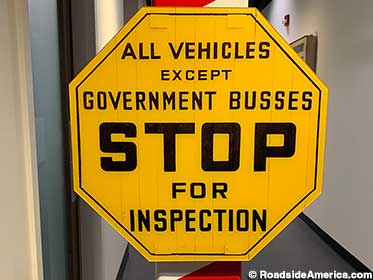
Security was always tight at K-25.
The K-25 History Center makes the point that Oak Ridge has moved on from the days of Little Boy. Exhibits call attention to modern, peaceful uses of atomic power, such as fuel for electric generating plants, medical isotopes for CAT scans, and the nuclear batteries in space telescopes and Voyager I and II, the furthest-away human objects in the universe. "We don't make bombs any more," said Quinn. "We make spacecraft." Oak Ridge has earned the right to champion the feel-good side of K-25, although it does tend to complicate an already complicated story. "We do get a lot of people," said Quinn, "who aren't quite sure what happened here."
Plans are in the works to attach an observation deck at the back of the K-25 History Center. Visitors will eventually be able to look out over the vast space, stretching to a distant ridgeline, formerly occupied by K-25 building, and see a panoramic view of... well, not much at all. Despite the years of clean-up, the empty plant site remains off-limits to the public. Maybe the Center can put Criticality Unit 1 back to work and hose down the property.





